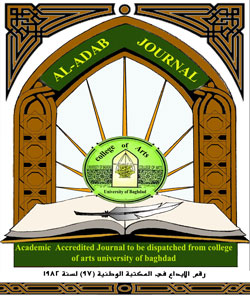The prophetic approach to building the military
Successful leadership and the ingredients for victory
DOI:
https://doi.org/10.31973/aj.v0i134.920Keywords:
military, establishment, leadershipAbstract
Every army in the world is made up of two components: physical and moral )Spiritual) components
Some leaders in the world gave a percentage of 75% to the spiritual (spiritual) component, including Napoleon Bonaparte, while the rest of 25% was given to the physical component.
Refining the behavior of individuals through the cultivation of religious belief is one of the greatest educational methods because religion has authority over hearts and souls and influences feelings, and its authority and influence are hardly to be rejected, so religion has had a great impact in raising the morale of the soldiers.
The Holy Qur’an has warned us in many verses not to go into warfare before the spiritual (moral) preparation and consolidation of belief in the soul, because fighting a war with few soldiers, those who have a firm belief writes to them victory in every time and place because it is not proven in the battlefield of the rogue except owners of firm belief, then it is necessary to make sure of spiritual preparation before entering the warfare and produce elements that do not have a belief because victory is not so much empty.
In this research, we will review the prophetic method in material preparation and building the military establishment.
Downloads
References
Ahmed, D. Khalil (Without History): The Book of Arabs and Leadership.
Al-Harmathi, A Brief War Policy.
Al-Mawardi, Royal Decrees.
Al-Qaradawi, Youssef, Faith and Life.
Al-Wafdi, Fattouh Al-Sham.
Amin, Lieutenant General Muhammad Fathi, War and Morale, Introduction to Islamic Military Doctrine and Strategy - Major General Muhammad Jamal al-Din.
Baydoun, Ibrahim: Features of Political Currencies in the First Hijri Century.
Driving brochure - an official brochure issued by the Ministry of Defense.
Ibn Abd Rabbo - The Individual Contract.
Ibn Al-Atheer (1979). Izz al-Din Abu al-Hasan Ali bin Muhammad bin Abi al-Karam al-Shaibani. Al-Kamil in History, volumes II and III, Dar Sader.
Ibn Asaker: The History of the City of Damascus.
Ibn Hajar, the injury in distinguishing companions.
Ibn Kathir - beginning and end.
Ibn Qutaiba, Interpretation of the Qur’an’s problem.
Journal of the Iraqi Scientific Academy, No. 1, volume 39.
Kabbani, D. Muhammad 2006, Al-Wajeez in the Rightly Guided Caliphate, First Edition Dar Al-Fateh - Dar Al-Qalam.
Khattab, Mahmoud Shit (1966): Omar Bin Al-Khattab: Al-Faruq Al-Qaid, Second Edition, Dar Al-Hayat Library.
Montgomery (1966): The Path to Driving, Beirut, Dar Al-Tale'ah Publications.
Morale brochure - an official brochure issued by the Moral Guidance Directorate - Ministry of Defense.
Narrated by Sheikh Al-Bukhari and Muslim - see Al-Lulu and Al-Murjan - hadith 1199. See the army and fighting in the chest of Islam - Mahmoud Ahmed Salman.
Salman, Mahmoud Ahmed, the army and the fighting in the midst of Islam.
The Armored Kill System, this book is from the military technical books to train the armed forces in the federation.
The Military Magazine, Vol. 3 Dhu Al-Hijjah 1409 AH 1989 AD - Directorate of Combat Development.
Downloads
Published
Issue
Section
License
Copyright and Licensing:
For all articles published in Al-Adab journal, copyright is retained by the authors. Articles are licensed under an open access Creative Commons CC BY 4.0 license, meaning that anyone may download and read the paper for free. In addition, the article may be reused and quoted provided that the original published version is cited. These conditions allow for maximum use and exposure of the work.
Reproducing Published Material from other Publishers: It is absolutely essential that authors obtain permission to reproduce any published material (figures, schemes, tables or any extract of a text) which does not fall into the public domain, or for which they do not hold the copyright. Permission should be requested by the authors from the copyrightholder (usually the Publisher, please refer to the imprint of the individual publications to identify the copyrightholder).
Permission is required for: Your own works published by other Publishers and for which you did not retain copyright.
Substantial extracts from anyones' works or a series of works.
Use of Tables, Graphs, Charts, Schemes and Artworks if they are unaltered or slightly modified.
Photographs for which you do not hold copyright.
Permission is not required for: Reconstruction of your own table with data already published elsewhere. Please notice that in this case you must cite the source of the data in the form of either "Data from..." or "Adapted from...".
Reasonably short quotes are considered fair use and therefore do not require permission.
Graphs, Charts, Schemes and Artworks that are completely redrawn by the authors and significantly changed beyond recognition do not require permission.
Obtaining Permission
In order to avoid unnecessary delays in the publication process, you should start obtaining permissions as early as possible. If in any doubt about the copyright, apply for permission. Al-Adab Journal cannot publish material from other publications without permission.
The copyright holder may give you instructions on the form of acknowledgement to be followed; otherwise follow the style: "Reproduced with permission from [author], [book/journal title]; published by [publisher], [year].' at the end of the caption of the Table, Figure or Scheme.












